Can you guess what movie or TV show we’re watching? We’ve turned on subtitles (when available) not to give you a clue, but to enhance that WTF effect! Leave your best guess in the comments to prove your true Flick Attackosity!
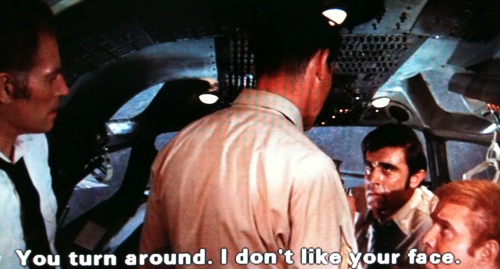
Can you guess what movie or TV show we’re watching? We’ve turned on subtitles (when available) not to give you a clue, but to enhance that WTF effect! Leave your best guess in the comments to prove your true Flick Attackosity!

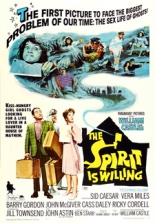
 Leave it to William Castle to turn a triple homicide into the basis for a comedy. The result is The Spirit Is Willing, a dispiriting effort from the usually reliable director. In fact, of all his films since Castle became a name brand with 1958’s Macabre, this is the only one I’ve seen that wasn’t at least mildly fun to watch. Even taking his minor works into account, from Zots! to Shanks, I didn’t think such an un-feat were possible.
Leave it to William Castle to turn a triple homicide into the basis for a comedy. The result is The Spirit Is Willing, a dispiriting effort from the usually reliable director. In fact, of all his films since Castle became a name brand with 1958’s Macabre, this is the only one I’ve seen that wasn’t at least mildly fun to watch. Even taking his minor works into account, from Zots! to Shanks, I didn’t think such an un-feat were possible.
At the same time, I wish it no ill will, because it’s entirely harmless and full of the good-naturedness that made Castle a matinee hero. Its focus is on a lovely, coastal, 19th-century home haunted by the ghosts of Ebenezer, Felicity and Jenny — a love triangle between a greedy man, his ugly wife and their attractive maid, all of whom kill one another in the jaunty, played-for-laughs prologue.
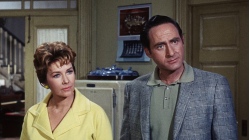 The trio of mute spirits has scared away residents for ages — depicted in a crudely drawn credit sequence — and the latest arrival is the Powell family, on an extended vacation: worrisome magazine editor Ben (Sid Caesar); his subservient wife, Kate (Vera Miles, Psycho); and their temperamental teenage son, Steve (Barry Gordon, The Girl Can’t Help It). As soon as the Powells move in, the ghosts get to work wreaking havoc, and Steve angrily shoulders the blame for all the damaged antiques and even sinking his uncle’s yacht.
The trio of mute spirits has scared away residents for ages — depicted in a crudely drawn credit sequence — and the latest arrival is the Powell family, on an extended vacation: worrisome magazine editor Ben (Sid Caesar); his subservient wife, Kate (Vera Miles, Psycho); and their temperamental teenage son, Steve (Barry Gordon, The Girl Can’t Help It). As soon as the Powells move in, the ghosts get to work wreaking havoc, and Steve angrily shoulders the blame for all the damaged antiques and even sinking his uncle’s yacht.
With guest turns from John Astin, Harvey Lembeck and Doodles Weaver, Spirit offers nothing that merits more than the rare, occasional smile. In fact, from today’s perspective, Steve’s outbursts are so violent, they provoked stress and discomfort in this viewer. For ghosts swirling around the heads of befuddled characters, Castle offered 13 of ’em in a far superior spookshow. This one’s just a rare misfire for the man. —Rod Lott
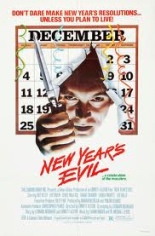
 Given all that bank made by Halloween and Friday the 13th, the immortal Cannon Films wanted to get in on some of that calendar-slasher action, making its stake on the holiday of hollow resolutions with the punny but cannily titled New Year’s Evil.
Given all that bank made by Halloween and Friday the 13th, the immortal Cannon Films wanted to get in on some of that calendar-slasher action, making its stake on the holiday of hollow resolutions with the punny but cannily titled New Year’s Evil.
It’s Dec. 31 in Los Angeles, and the big show is the New Wave New Year’s countdown, Hollywood Hotline, staged at a hotel and hosted by Blaze, a supposed punk-rock diva played by a blah Roz Kelly (aka Pinky Tuscadero of TV’s Happy Days). The live show gets off to a grand start when a caller identifying himself as “Evil” says he’s going to kill someone when the clock strikes midnight at each of the contiguous United States’ four time zones, culminating in Blaze’s death.
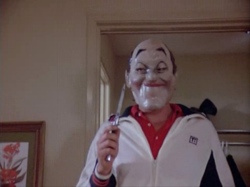 What makes New Year’s Evil different from many slashers is that after the prologue, director Emmett Alston (9 Deaths of the Ninja) makes no effort to hide the identity of the killer. Evil’s played by Kip Niven (Magnum Force), he of the feathered hair, Fila track suit, occasional Bob Hope-esque mask and mobile tape recorder, which he calls a “miracle of modern technology.” Using a variety of disguises and pick-up lines (“There’s a big party up at Erik Estrada’s place”), he finds a woman or two to slay every hour, on the hour. “Auld Lang Syne,” bitches!
What makes New Year’s Evil different from many slashers is that after the prologue, director Emmett Alston (9 Deaths of the Ninja) makes no effort to hide the identity of the killer. Evil’s played by Kip Niven (Magnum Force), he of the feathered hair, Fila track suit, occasional Bob Hope-esque mask and mobile tape recorder, which he calls a “miracle of modern technology.” Using a variety of disguises and pick-up lines (“There’s a big party up at Erik Estrada’s place”), he finds a woman or two to slay every hour, on the hour. “Auld Lang Syne,” bitches!
Among Evil’s victims are a nurse (Taafee O’Connell, Galaxy of Terror), a bar-hopping dumb blonde who discusses diarrhea (Louisa Moritz, The Last American Virgin) and a young Teri Copley (Brain Donors), whom he catches mid-makeout at the drive-in. The film’s “twist” is startlingly obvious to anyone who pays attention the overacting of Blaze’s sad-sack son (Grant Cramer, Hardbodies) in the early scenes, and Alston has one scare scene up his sleeve that I bet worked wonders in theaters. Regardless, Niven’s multifaceted performance is such a mad gas, it makes the movie well worth watching. —Rod Lott
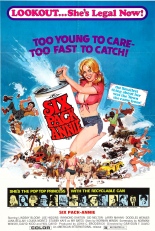
 Looking like Reese Witherspoon with actual breasts, Lindsay Bloom (TV’s The New Mike Hammer) fronts the sexy, saucy and supremely silly hick pic Sixpack Annie. The young filly drives a beat-up Ford pickup truck whose seat she often shares with pull-tab cans of Miller nestled snugly in a dirty Styrofoam cooler. And she’s so hot, I’ll forgive the title’s error of not self-hyphenating.
Looking like Reese Witherspoon with actual breasts, Lindsay Bloom (TV’s The New Mike Hammer) fronts the sexy, saucy and supremely silly hick pic Sixpack Annie. The young filly drives a beat-up Ford pickup truck whose seat she often shares with pull-tab cans of Miller nestled snugly in a dirty Styrofoam cooler. And she’s so hot, I’ll forgive the title’s error of not self-hyphenating.
The AIP cornpone comedy focuses on Annie’s attempts to save her aunt’s diner, where Annie waitresses in short shorts, from bank foreclosure. Her solution is simple: Just find a “sugar daddy.” In the small town of — ahem — Titwillow where she lives, works, drinks, trespasses, skinny-dips and speeds, the pickings are as slim as her waist, although everyone wants to bed her. That includes the guy they call Long John, whose license plate reads “9 INCHES.”
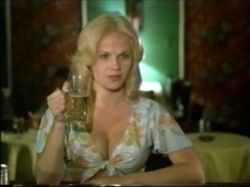 So Annie and her BFF Mary Lou (Jana Bellan, American Graffiti) head to Miami Beach to land a rich man, and take tips from Annie’s sister (Louisa Moritz, Death Race 2000), who works there as a flatulent, busty hooker. The jokes wrung out of every situation are goofy, sometimes stooping to the level of literally banana-peel humor. But damned if Bloom doesn’t go at it whole-hog, injecting the white-trash shenanigans with as much bubbly effervescence as the periodic bottle of Dr Pepper. The soda giant must’ve paid for the product placement, because it’s practically a supporting character.
So Annie and her BFF Mary Lou (Jana Bellan, American Graffiti) head to Miami Beach to land a rich man, and take tips from Annie’s sister (Louisa Moritz, Death Race 2000), who works there as a flatulent, busty hooker. The jokes wrung out of every situation are goofy, sometimes stooping to the level of literally banana-peel humor. But damned if Bloom doesn’t go at it whole-hog, injecting the white-trash shenanigans with as much bubbly effervescence as the periodic bottle of Dr Pepper. The soda giant must’ve paid for the product placement, because it’s practically a supporting character.
Plus, Sixpack Annie boasts the best ending in motion-picture history, when the Titwillow sheriff (Joe Higgins, Flipper) puts on his hat and doesn’t realize Mary Lou has filled it with milk! And then he walks into a midget (Billy Barty) carrying a tray of cream pies, causing the desserts to smash in the little guy’s face! And then the angry dwarf gets revenge by smashing a pie into the sheriff’s face! And the sheriff is so mad that steam practically shoots out his ears! (Should I have added “spoiler alert” before all that?)
Also, there’s a song called “Them Red Hot Nuts.” —Rod Lott
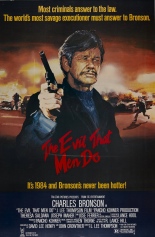
 Here’s how you know The Evil That Men Do is going to be another Charles Bronson bad-asser: The film’s first shot is a slowed-down grab from a much later scene, of him throwing a knife just to the left of frame. This should’ve been used to start all his ’80s action movies, like his version of the 007 gun-barrel sequence; after all, Bronson’s post-Death Wish characters were pretty much variations of the same one-man-war assassin. Not that there’s anything wrong with that, and in my book, there isn’t.
Here’s how you know The Evil That Men Do is going to be another Charles Bronson bad-asser: The film’s first shot is a slowed-down grab from a much later scene, of him throwing a knife just to the left of frame. This should’ve been used to start all his ’80s action movies, like his version of the 007 gun-barrel sequence; after all, Bronson’s post-Death Wish characters were pretty much variations of the same one-man-war assassin. Not that there’s anything wrong with that, and in my book, there isn’t.
Dr. Molloch (Joseph Maher, Under the Rainbow) may be the sickest of all Bronson villains. Often seen wearing an executioner’s black hood, the physician schools the troops of some 20 countries in how to maximize pain and torture of one’s enemies. South America is the latest.
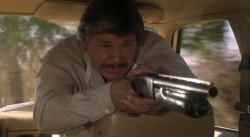 Meanwhile, professional hit man Holland (Bronson, duh) is enjoying retirement in the Cayman Islands when he learns an old buddy has been killed while trying to take out Molloch. Reluctantly, Holland agrees to assassinate the Doctor, and travels to Central American under the guise of a family man, with his friend’s widow (Theresa Saldana, Raging Bull) and daughter.
Meanwhile, professional hit man Holland (Bronson, duh) is enjoying retirement in the Cayman Islands when he learns an old buddy has been killed while trying to take out Molloch. Reluctantly, Holland agrees to assassinate the Doctor, and travels to Central American under the guise of a family man, with his friend’s widow (Theresa Saldana, Raging Bull) and daughter.
Directed by frequent collaborator J. Lee Thompson (10 to Midnight), the nicely nasty Evil is thought to be one of Bronson’s most violent pictures, and I can not disagree. For example, when the Mexican equivalent of Richard Kiel paws and licks a disgusted Saldana in a bar, Holland subdues the giant by grabbing his penis and bending it, eventually using both hands. I had to wince and cheer. But Evil is not without humor, too, like when Holland is trapped under a bed while lesbian-loving occurs above him (the evil that women do?), and he’s practically smashed by the moving mattress. Dammit, do I miss this guy. —Rod Lott